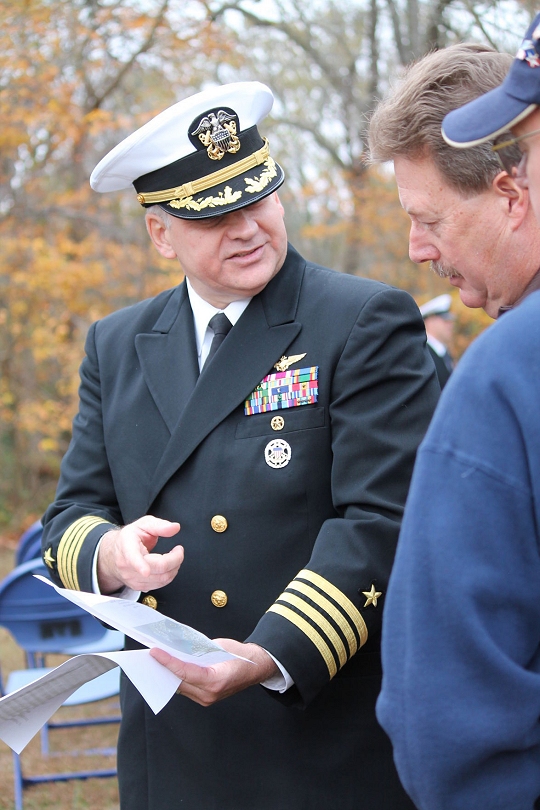 NAS Patuxent River Commanding Officer Capt. Scott Starkey. (U.S. Navy photo)
NAS Patuxent River Commanding Officer Capt. Scott Starkey. (U.S. Navy photo)PATUXENT RIVER, Md. (August 24, 2017)—NAS Patuxent River Commanding Officer Capt. Scott Starkey will close another chapter in his naval career as he stands before a crowd of Sailors, family, well-wishers and coworkers in Hangar 110 and turns over command of the installation to Executive Officer Capt. Jason Hammond Aug. 31.
Starkey believes the opportunities he seized throughout his career are what led him to where he is today—and where he continues to go—as he moves forward to his next duty assignment aboard NAS Corpus Christi, Texas.
Deciding on the military
A Maryland native son, Starkey was born at Walter Reed Medical Center in Washington, D.C., after his father was drafted into the Army. He lived for a time with his parents in Kansas but after his father left the Army, the family came back and settled in Prince George's County until he was 18 years old.
"I knew I wanted to fly and be in the service," Starkey said. "Both of my grandfathers were in the Navy during World War II but that didn't drive my decision. I was in NROTC at Virginia Tech and one thing led to another."
Graduating college with a B.S. in math, Starkey received his commission and joined the Navy in December 1991. He was designated a Naval Aviator in April 1994.
Beginning of a career
Following H-3 fleet replacement pilot training with Helicopter Antisubmarine Squadron (HS) 1, Starkey reported to Helicopter Combat Support Squadron (HC) 2 in March 1995 where he completed two deployments with the Desert Ducks in Bahrain, providing support to Commander, Fifth Fleet.
"I started with the H-3 then went to the H-60," noted Starkey, who still flies H-60s today with the Pax River Search and Rescue (SAR) team. "Everybody likes their first aircraft, but the H-3 is gone now."
Whenever an opportunity presented itself, Starkey took advantage of it.
"I learned something new from each one and when the next one came up, I took that." he said. "Once it starts, it keeps on going. I never really planned to stay in the Navy, but I think what kept me in is that every tour gave me something new and challenging to do; that happened every single time. There are at least four times in my career when I took advantage of an opportunity, and if I hadn't, I probably wouldn't be sitting here today."
One of his biggest challenges occurred from April 2001 to August 2003, when he stopped flying for a time and served as assistant navigator on the aircraft carrier USS Enterprise (CVN 65), deploying in support of Operations Southern Watch and Enduring Freedom.
"It's what's called a 'disassociated sea tour' and it takes you out of your comfort zone," Starkey explained. "I didn't know anything about driving a ship; I'd been flying for three years. But every day I went up on duty and every day I tried to learn a little more. That was probably one of my most challenging tours."
Arriving at Pax River
Rotating every tour, Starkey was in something of a round robin between Jacksonville, Norfolk and San Diego before stopping at the Pentagon from 2010 to 2013. He took command of Pax River April 14, 2016, after serving as the installation's executive officer, a position that falls under the Navy's Fleet-Up program.
"Eighteen months as XO and 18 months as CO is how we fleet-up at most air stations," Starkey said. "It gives you a little less time to be the guy in charge, but you have a buildup period beforehand so that you know what you're doing when you take over."
CO's role and responsibilities
Starkey was familiar with Pax River, having spent four months here as a member of (HX) 21 more than 20 years before taking command, but he's never ceased to be amazed by the size and scope of the air station and its operations.
"This base was built to develop future naval aviation technology and the base CO is responsible for keeping it running so our tenant commands can accomplish their mission," he explained from his office in Building 409, which has housed the base CO since the installation's construction in 1943. "It's a 24-hour job. We have people working all the time and they're incredible. We have funding challenges and so much is happening, yet they're still able to get the job done. And when you learn more about what they do, you appreciate them even more."
In addition to his duties aboard Pax, Starkey served as the "face of the base" outside the fenceline.
"Whether here or out in town, it's all about building relationships and the influence and knowledge you obtain from doing that," he noted. "We have outside support from the community that's the best I've seen in the Navy. The community is related to the base and the base to the community. We work together."
Accomplishments, advice, thanks
The Zone Inspection Program, where NAS leadership visits each building on base, spawned what Starkey calls "ownership"—taking the initiative to correct whatever may be wrong without waiting for someone else to notice and take care of it.
"Ownership is the biggest thing while I was here," he said. "These are everyone's buildings. Whether NAWCAD or CNIC is paying for maintenance, if the people who work here take ownership and pick up trash, don't accept broken things, or report wrong-doing, then we make progress; and we're beginning to see that ownership from everyone on base."


